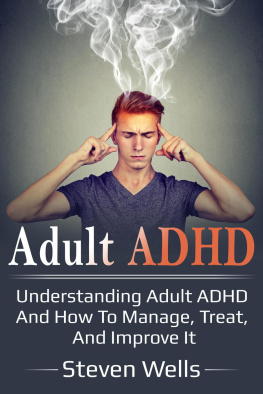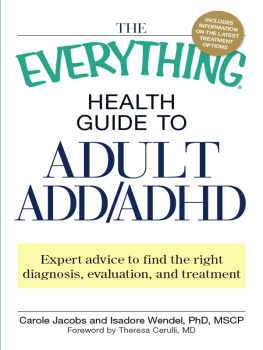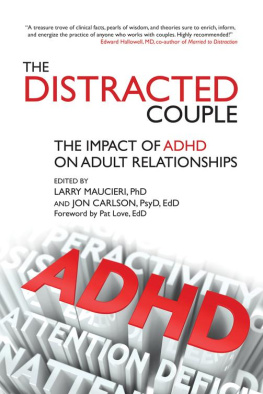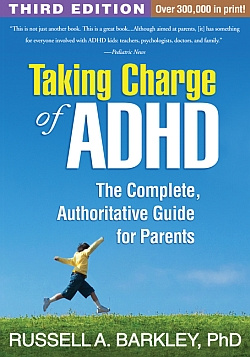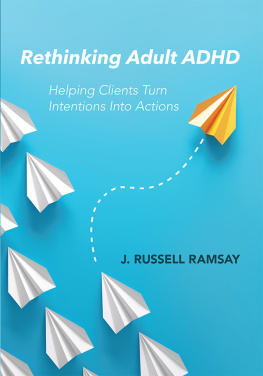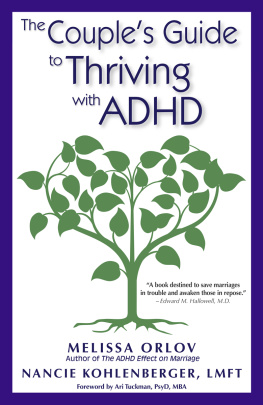Adult ADHD
Understanding adult ADHD and how to manage, treat, and improve it
Table of Contents
T hank you for taking the time to read this book on adult ADHD.
This book covers the topic of adult ADHD, and will explain how the condition may affect you as an adult.
Most people believe that ADHD only affects people in childhood, but for some it actually continues throughout adulthood. This can have a dramatic impact on a persons career, personal life, and relationships.
This book will explain to you the different symptoms that may be present in adult ADHD, as well as provide you with a wide array of strategies for managing these symptoms.
At the completion of this book you will have a good understanding of adult ADHD, and be fully prepared to manage the symptoms, as well as use them to your advantage when possible!
Once again, thanks for choosing this book, I hope you find it to be helpful!
Chapter 1: What is Adult ADHD
O verview
Attention-deficit/hyperactivity disorder or ADHD is a mental health condition. Adults with ADHD are repeatedly inattentive, hyperactive, and impulsive. This gets in the way of performing tasks and interacting with others.
Here are examples of how people with ADHD behave:
Inattention | Hyperactivity | Impulsiveness |
- Wanders off from tasks
- Lacks persistence
- Shot attention-span Disorganized
| - Constantly moves around even at unsuitable times
- Excessively taps, talks, or fidgets
- Wears others out by being restless
| - Makes hasty actions/decisions without considering safety or long-term consequences
- Always desires immediate rewards
- Relentlessly interrupts others
|
Others may assume that they act this way out of defiance or by lack of comprehension. As a result, people with ADHD often encounter other personal problems. Most have low self-esteem, poor performance at work/school, addictions, and unstable relationships.
Although it is commonly observed in children, ADHD can continue through adulthood. In some cases, it is not recognized until the person is already an adult.
Many children grow up with ADHD. Hyperactivity may decrease in adults, but they will still be restless and impulsive. Many will still have short attention-spans.
Causes and Risk Factors
Studies do not point to a single specific cause for ADHD. Instead, there are many genetic and environmental factors that contribute to its development.
ADHD can be hereditary. Between 50% to 75% of parents with ADHD will likely have children with ADHD. If an older child has it, the younger child has a 30% chance of having the same disorder. A person who has a twin with ADHD is likely to develop the condition, too.
Genes play a huge role in determining who develops ADHD. Studies show that small pieces of DNA are either duplicated or missing in the brains of people with ADHD. These defective DNA segments are also associated with autism and schizophrenia.
Unfortunately, inheriting the genes associated with ADHD cant be controlled. Parents with ADHD should keep a watchful eye for symptoms developing in their child. They should also alert the childs pediatrician on the familys history of ADHD.
- Smoking cigarettes, drinking alcohol, and using drugs during pregnancy
A pregnant womans vices will harm the baby she is carrying.
Nicotine and carbon monoxide from cigarette smoke affect the childs brain development. Mothers who smoke during pregnancy increase their children's chances of developing ADHD.
Drinking too much alcohol also puts the baby at risk. Kids with ADHD are 2.5 times more likely to have been exposed to alcohol inside the womb.
Similarly, drug abuse during pregnancy also exposes the baby to harmful chemicals that potentially inhibit the childs normal brain growth.
- Exposure to toxic chemicals, like lead, at a young age
Lead has a harmful effect on child development. This chemical is commonly found in paint and gasoline. Despite its bad reputation, it continues to be used throughout the world.
Some toys have traces of lead paint in them. Leaded gasoline is banned in most countries, but it remains legal in Algeria, Iraq, Myanmar, North Korea, and Afghanistan. Even today, airplane gasoline is still leaded.
Lead exposure affects the childs IQ and increases their risk of developing ADHD. It disrupts decision making, personality expression, and social behavior.
Extremely low birth weight has been associated with mental health problems like ADHD. Those who are born this way have higher rates of shyness, depression, and anxiety.
When a babys weight is not normal, their body undergoes a lot of stress. This triggers biological responses that affect the brains chemical balance.
Being born with a low birth weight merely increases the risk of having psychological disorders, but it does not cause them. Most low weight babies will not develop mental problems later in life.
Head injuries can trigger mental conditions, including secondary ADHD (SADHD). This type of ADHD is caused by serious brain trauma.
New studies suggest that it can take up to a decade for symptoms to show up. Those who have sustained head injuries should be aware of this.
Treatment and medication for ADHD and SADHD are the same.
Teens who are glued to their smartphones are more likely to develop ADHD symptoms than those who arent. This was a result of a study involving 2,500 Los Angeles high school students. None of them had ADHD symptoms at the start of the study.
Adolescents who regularly checked on their phones had shorter attention spans. Meanwhile, binge-watching videos interferes with the development of patience and impulse control. Exposure to too much digital media weakens one's ability of delaying gratification.
Experts are still debating whether screen time does indeed cause ADHD. It is also possible that those who develop ADHD are simply drawn to digital media. Even so, the study suggests that the use of smartphones and tablets should be regulated.
Food additives are widely believed to cause hyperactive behavior in some children. These additives include artificial sweeteners, artificial colors, and preservatives. So far, there are only a few studies that support this claim.
While it is important to be careful with what to eat, eliminating too many foods in your diet can be unhealthy. The best approach is to limit sugary and processed foods.
Next page
